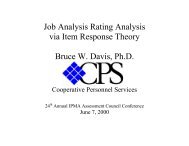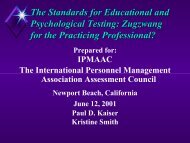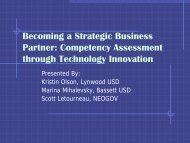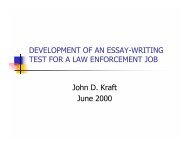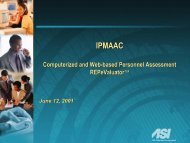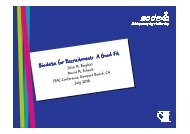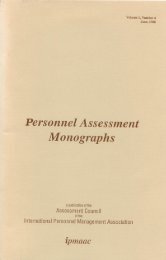A Competency Dictionary For The Canadian Forces And Its ... - IPAC
A Competency Dictionary For The Canadian Forces And Its ... - IPAC
A Competency Dictionary For The Canadian Forces And Its ... - IPAC
- No tags were found...
You also want an ePaper? Increase the reach of your titles
YUMPU automatically turns print PDFs into web optimized ePapers that Google loves.
Background• Chief Defence Staff vision 2005• Chief Military Personnel mandate– Initiatives 2008 (Director General Military Personnel)• Succession Planning Review• Personnel Appraisal System Review1
Current CF Succession Planning Process• Starts at the Colonel level• Environment specific (annual Succession planning board made up of achair—Environment Deputy Comd— and members at the rank of MGen/RAdmand BGen/Cmdre )• No standardized use of a framework upon which to guideselection across environments• CF highly successful at developing leaders for operationalcommand positions but not as much for strategic positions(LGen (Ret’d) Jeffery, 2008)2
4GO/FO’s Employment Structure (Jeffery,2008)
<strong>Competency</strong> gaps (Jeffery, 2008)• At this level of rank, you would expect and need officers to:– have a broad perspective;– understand the complexities of Ottawa, and the value of the differentorganizational cultures– understand the corporate environment;– have enhanced communication skills; and– have enhanced strategic and critical thinking skills.• Senior leaders are selected correctly but because of the focus oncommand:– some of them arrive on the job not feeling adequately prepared for jobs inthe secondary streams.5
Working group sessions withEnvironmental Representatives• Results :– Resistance to the adoption of a fully standardizedapproach to succession planning across the threeenvironments;– Strong agreement that:• succession planning should start at lower ranks (i.e.,Major/LtCdr(N)),• the CF needs to place greater emphasis on thedevelopment of those skills; and• the adoption of a common competency frameworkwould help eliminate these weaknesses and wouldbring about better prepared senior leaders6
<strong>The</strong> Leadership Development Framework (LDF)Social CapacitiesProfessional IdeologyProfessional ExpertiseCognitive CapacitiesChange Capacities7
Succession Planning Project: Development ofa CF <strong>Competency</strong> <strong>Dictionary</strong>• Development of a competency dictionary:– Operationalization of the LDF:• Clear and validated definitions of the required competencies• Validated occupational and rank-based behavioural indicators:– Improved standardization– Improved assessment/selection of leaders– Improved identification of personnel strengths andweaknesses– Improved and more tailored developmental activities– LDF ValidationBetter Support to Succession Planning8
Development of CF <strong>Competency</strong> <strong>Dictionary</strong>• Identifying the competencies– Review of the Combat Arms Colonel competency profile(Joanisse & Vezina, 2007)– Mapping exercise (Burgess, 2010)• Defining the competencies– Best practices review– CF and Allied countries Military leadership models andliterature“Making everyone happy”9
CF <strong>Dictionary</strong> of Competencies (draft)ExpertiseOrganizational AwarenessVisioningResults ManagementResource ManagementInformation ManagementTechnical ExpertiseChange CapacitiesDeveloping Self and OthersBehavioural FlexibilityChange ManagementStress Tolerance and ManagementCognitive CapacitiesCreativityAnalytical ThinkingSystems ThinkingProfessional IdeologyCommitment to the CF Military EthosMoral ReasoningCredibility and ImpactAction Orientation and InitiativeSocial CapacitiesInterpersonal RelationsCommunicationTeamworkPartnershipConflict ManagementService Orientation10
Succession Planning Project: Interview Phase• A third of the Col/Capt(N) in each of the five job families (Chief Of Staff,<strong>Canadian</strong> Defence Attaché, Project Manager, Commander, Director) wereinterviewed• Interviews for specialists (e.g., Medical Doctors) and OUTCAN (e.g.,Liaison Officers) have been postponed until Fall 2011• Col/Capt(N) interviews• Validate competency definitions• Further develop the CF competency dictionary at Col/Capt(N) rank• Establish draft competency profiles according to Col/Capt(N) job family(e.g., Chief of Staff, Commanders, Directors, etc.)• Validate job descriptions• Gather information as per the knowledge and experience they need tobe successful in the job11
Interview Process• Each Col/Capt(N) is sent preparatory material prior to theinterview:• Draft definition of the 23 competencies• <strong>Competency</strong> ranking form• Knowledge questionnaire• <strong>The</strong> interview (duration average=1.5 hour)• Ice breaker• Questions related to day to day work activities in specific job• Questions on four of the 23 competencies• Questions to establish differences between current rank and rankbelow• Readiness questionnaire• Presentation of job description• Closing comments/critical incident form12
<strong>The</strong> Analysis Process• Interviews– Each interview was recorded digitally and then transcribed into text for analysis– Interview analysis done individually and consensus reached as a group of threeSMEs who took part in the interview process• Content analysis of each interview, highlighting the competencies and BehaviouralIndicators (BIs) found. Typically between 7-14 competencies can be observed perinterview.• Attribution of competency level to each competency and BI based on current draftdictionary.• Aggregation of each competency and its associated level for interviews within a job family.• <strong>Competency</strong> Ranking <strong>For</strong>ms• Data base entry of forms for data analysis (frequencies and descriptive statistics).• Comparison of results from both the interviews and ranking forms to establish trends for theestablishment of competency profile for each job family.• Knowledge Questionnaires• Data base entry of knowledge questionnaires for data analysis (frequencies and descriptivestatistics).• Comparison of results from both the interviews and knowledge questionnaire to establish trendsrelated to knowledge and experience.13
General Observations• <strong>The</strong> competency definitions are generally accepted as is with very few minoredits suggested.• <strong>The</strong> interview analysis is providing support to the pre-established BehaviouralIndicators (BI) at the Col/Capt (N) rank and leading to the development ofsome additional BIs.• Clear patterns seem to be emerging within the different job families withregards to:– <strong>The</strong> competencies particular to the job family– <strong>The</strong> level of competence required of each of the competencies– <strong>The</strong> experience and knowledge required to perform effectively in the job• We can see the emergence of a core set of competencies for the Col/Capt(N)rank.14
General Observations (cont)• Preliminary evidence of overlap with regard to some of the competencies isobserved from the interview analysis:– Systems Thinking with Organizational Awareness and Analytical Thinking– Moral Reasoning with Commitment to Military Ethos– Service Orientation with Commitment to Military Ethos– Information Management with Communication• Differences in personal leadership style may be impacting some of theobservations with regard to some competencies.15
Chief of Staff (COS) <strong>Competency</strong> Profile (draft)Core CompetenciesCol/Capt(N)Critical CompetenciesChief of StaffCredibility and ImpactAction Orientation and InitiativeResource ManagementCommunicationInterpersonal RelationshipsTeam workAnalytical ThinkingOrganizational AwarenessBehavioural FlexibilityPartnering16
Commander (CO) <strong>Competency</strong> Profile (draft)Core CompetenciesCol/Capt(N)Credibility and ImpactAction Orientation and InitiativeResource ManagementCommunicationInterpersonal RelationshipsTeam work17Critical CompetenciesCommanderAnalytical ThinkingCommitment to Military EthosOrganizational AwarenessVisioningResult ManagementPartnering
Defence Attaché (CDA) <strong>Competency</strong> Profile(draft)Core CompetenciesCol/Capt(N)Critical CompetenciesDefence AttachéCredibility and ImpactAction Orientation and InitiativeResource ManagementCommunicationInterpersonal RelationshipsTeam workCommitment to Military EthosOrganizational AwarenessBehavioural FlexibilityPartnering18
Project Director/Manager (PD/PM) <strong>Competency</strong>Profile (draft)Core CompetenciesCol/Capt(N)Critical CompetenciesProject Director/ManagerCredibility and ImpactAction Orientation and InitiativeResource ManagementCommunicationInterpersonal RelationshipsTeam workAnalytical ThinkingResult ManagementChange ManagementPartnering19
Project Director <strong>Competency</strong> Profile (draft)Core CompetenciesCol/Capt(N)Critical CompetenciesDirectorCredibility and ImpactAction Orientation and InitiativeResource ManagementCommunicationInterpersonal RelationshipsTeam workAnalytical ThinkingResult ManagementVisioningPartneringOrganizational Awareness20
Example Of Draft End Product: Chief of Staffinformation (P.1)CHIEF OF STAFFSECTION 1 - JOB IDENTIFYING INFORMATIONJOB TITLE: Chief of StaffJOB ABBREVIATION: COSRANK: Colonel/Captain(N)PHYSICAL JOB ENVIRONMENTS: Office/Field# OF POSITIONS:SECTION 2 - FUNCTIONAL DESCRIPTION<strong>The</strong> Chief of Staff (COS) is a job at the Colonel/Captain(Navy) rank level. <strong>The</strong> job is performedin the office and supports the Sea, Land, and Air elements.<strong>The</strong> primary responsibility of the Chief of Staff is to ensure the efficient coordination of the dayto-dayactivities in the Personnel, Logistics, Engineering, Infrastructure, and InformationManagement/Information Technology (IM/IT) support to all organizations.SECTION 3 - RESPONSIBILITYAdvise Commander on policies and plans pertaining to materiel acquisition and support,personnel administration (aspects relating to the Personnel Support Programme (PSP) andNon-Public Property (NPP/NPF)), the environment, Health and Safety and Safety, realtyassets, fire protection, security and emergency response, and Official Languages;Monitor, analyze and report to the Commander on the effectiveness of the organizations inmeeting approved goals and objectives and represent their resource requirement at ResourceManagement Steering Committee;Develop, formulate, implement and enforce policies, procedures, and operating practicesrelating to discipline, training, safety, administration, and performance appraisals;Guide the collation of higher level MATERIEL policy and direction into appropriate Orders,advisories and directives;Identify unit capabilities and staffing options for CO/COMD consideration;Staff correspondence relating to all MATERIEL support matters on behalf of Commander.Provide leadership on the management of financial, human and materiel resources;Ensure information flow between the staff and commander on staff recommendations and thecommander’s decision;Integrate staff efforts in the pursuit of the CO/COMD’s guidance, direction and objectives;Supervise the unit level support staff, foster a professional, non-discriminatory workenvironment; andExercise leadership through personal example, moral responsibility and judicious attention tothe welfare of subordinates.21
Example Of Draft End Product: Chief of Staffinformation (P.2)SECTION 4 - COMPETENCYPL1 PL2 PL3 PL4 PL5OrganizationalCompetenciesCommitment to CF military ethosCoreCompetencies(Colonels)Interpersonal RelationsBehavioural FlexibilityResource ManagementTeamworkCriticalCompetencies(Chief of Staff)Analytical ThinkingInformation ManagementAction Orientation & InitiativePartneringAdditionnalCompetencies(Chief of Staff)Stress Tolerance & ManagementChange ManagementCreativityProfessionalExpertiseCommandHuman ResourcesFinanceKnowledgeBasic knowledge of the CF and/or environmental operations being supportedDetailed knowledge of CF personnel policies & administration, as well as, <strong>Canadian</strong>Government regulations/ policies as they pertain to the CF, and/or environmentalresponsibilities and procedures, programme delivery processes and authorities, issuesanalysis, estimation, procurement, HR and financial management techniques,regulations and procedures.ExperienceWith the NCR environment dealing with agencies and various level of governmentdepartments outside of the CF as well as working with DND civilians and reservists.22
23Succession Planning Model Proposed
24Example of Draft Succession Planning form(COS)
Next Steps• Once all Col/Capt(N) interviews are analyzed, the profiles resulting fromthe analysis will need to be validated.• Since January, efforts have been made to ensure that the new electronicHR system to be implemented in 2014 will support the succession planningapproach/competency profiles.• Future leader identification and assessment tools are being studied.• In the fall 2011, interviews will start for the Brigadier general/Commodorerank.• Our recommendation is for the CF to start their succession planning withmembers at the Major/LtCdr(N) rank.• Interviews/focus groups for the ranks of Majors and Lieutenant Colonelswill follow the work that will be done on Brigadier general.• Work on validating the competency dictionary will be on going and willexpand to NCMs.25
Thank you!Line.St-Pierre@forces.gc.caCheryl.Burgess@forces.gc.ca26



